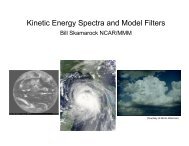Detecting Thermals Remotely - AOSS Research
Detecting Thermals Remotely - AOSS Research
Detecting Thermals Remotely - AOSS Research
- No tags were found...
Create successful ePaper yourself
Turn your PDF publications into a flip-book with our unique Google optimized e-Paper software.
<strong>Detecting</strong> <strong>Thermals</strong><strong>Remotely</strong>Nilton Renno, Stephen Rogacki,Michael Parker, Brian Russell, RobbGillespie, and William Rogerse-mail: renno@alum.mit.edu
Outline• Fair weather electric fields– The global electric circuit– Electric field in thermals• Previous investigations• Theoretical predictions• A new electric field sensor• Measurements– From the ground– Airborne• Conclusions
Fair weatherelectric fields
The global electric circuitIonosphere+ + + + + + + + + + + + + + + + + + +500 kV~ 100 lightning strikes per sec2 pA/m 2I- - - - - - - - - - - - - - - - - - - - - - - -Surface
Electric fields in thermals+ + + + + + + + + + + + + + + + + + +EE- +- + ++ + + ++ + - + + + + - + + - + + + +- - - - - - - - - - - - - - - - - - - - - - - -
Results of previousinvestigationsMarkson, 1975see also Kohl, 1968
A new electric fieldsensor- -- - -- -- - -- - -- - - -- - -- - - -+ + + +
Requirements• To distinguish the ambient space fieldfrom the effects of charged particlescolliding with the sensor– Vary the rotation rate during measurements(Maruvada et al. 1983)– Add sharp points to limit the sensor potential• To measure the electric fields ~ 1 cm fromthe surface– Instrument diameter ~ 1 cm
Sensor characteristics• DC to > 10 Hz• Range: 1 to 10 6 V/m• Resolution: 1 V/m• 2-d vector field (plane of rotation)• A version of the sensor for gliders will bedeveloped– We plan to study the idea on installing it in awinglet
Installation on EP
Measurements at theground
Ground measurements on May 28, 2008from 14:16:25 to 16:11:00 local timestrong thermals selected for study1231 2 31 2 3
Thermal #1 (vertical plane)reduction in magnitude and rotation of the electric fieldthermal gusts
Thermal #1 (horizontal plane)increases in the magnitude of the electric field correlatedwith thermal gusts
Thermal #2 (vertical plane)variations similar to that of thermal #1
Thermal #2 (horizontal plane)variations similar to that of thermal #1
Flights at the TuSC inArizona
Flight Path July 02, 2008
July 02, 2008Start of flight1 2End of flight
Start of flightJuly 02, 2008(2 - 60 s average)1 2End of flight
July 02, 2008Thermal #1~ 2 km
July 02, 2008Thermal #1 (2 - 60 s average)Indication that the thermal is not centered?
July 02, 2008Thermal #2~ 1 km
July 02, 2008Thermal #2 (2 - 60 s average)~ 1 km
Flight path July 04, 2008
July 04, 20081 2 3
July 04, 2008(2 - 60 s average)1 2 3
July 04, 2008Thermal #1Left wing on insideRight wing on inside
July 04, 2008Thermal #1 (2 - 60 s average)~ 2 km
July 04, 2008Thermal #2~ 1.2 km
July 04, 2008Thermal #2 (2 - 60 s average)
July 04, 2008Thermal #3
July 04, 2008Thermal #3 (2 - 60 s average)~ 1.2 km
Conclusions
• Our measurements suggests that thermalscan be detected remotely with a passiveelectric field sensor• The 60 s average electric field appears toincrease steadily toward thermals– The first derivative of the electric field might be agood indicator of the approach of a thermal– The direction of the local field might be a goodindicator of the direction of the thermal• The electric field might also be used forcentering thermals– There is a maximum in the vertical component ofthe electric field at the center of the thermal
Plans for the future• Additional measurements will be conducted:– In various regions and weather conditions– With a data logger recording the electric field, GPSposition, and TE rate of climb– With measurements of the gradient and ACcomponents of the field near thermals• The position of the glider with respect to thethermals will be analyzed– The electric field will be used to locate the direction ofthe thermals– The idea of using the electric field for centeringthermals will be tested
Thanks!





